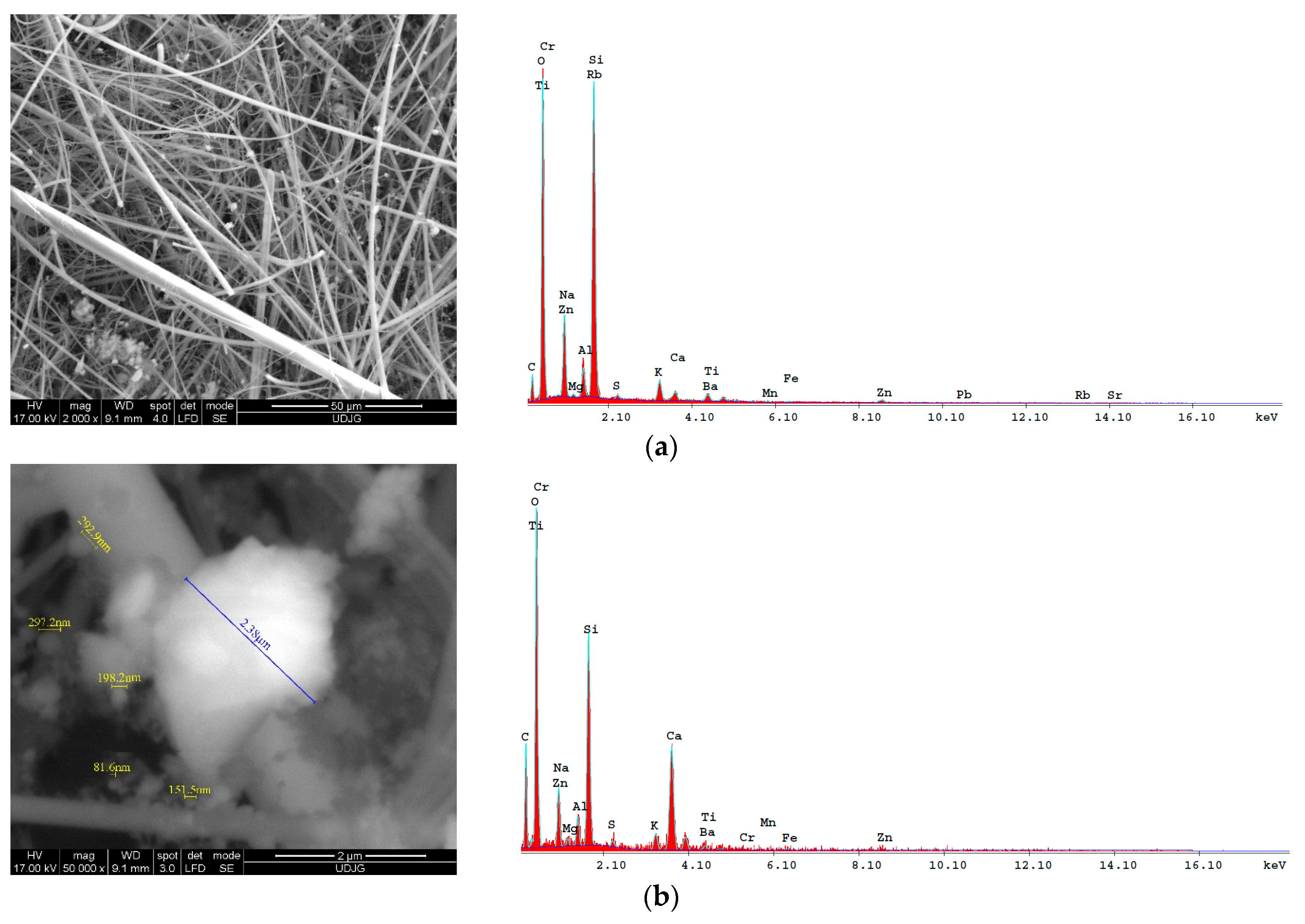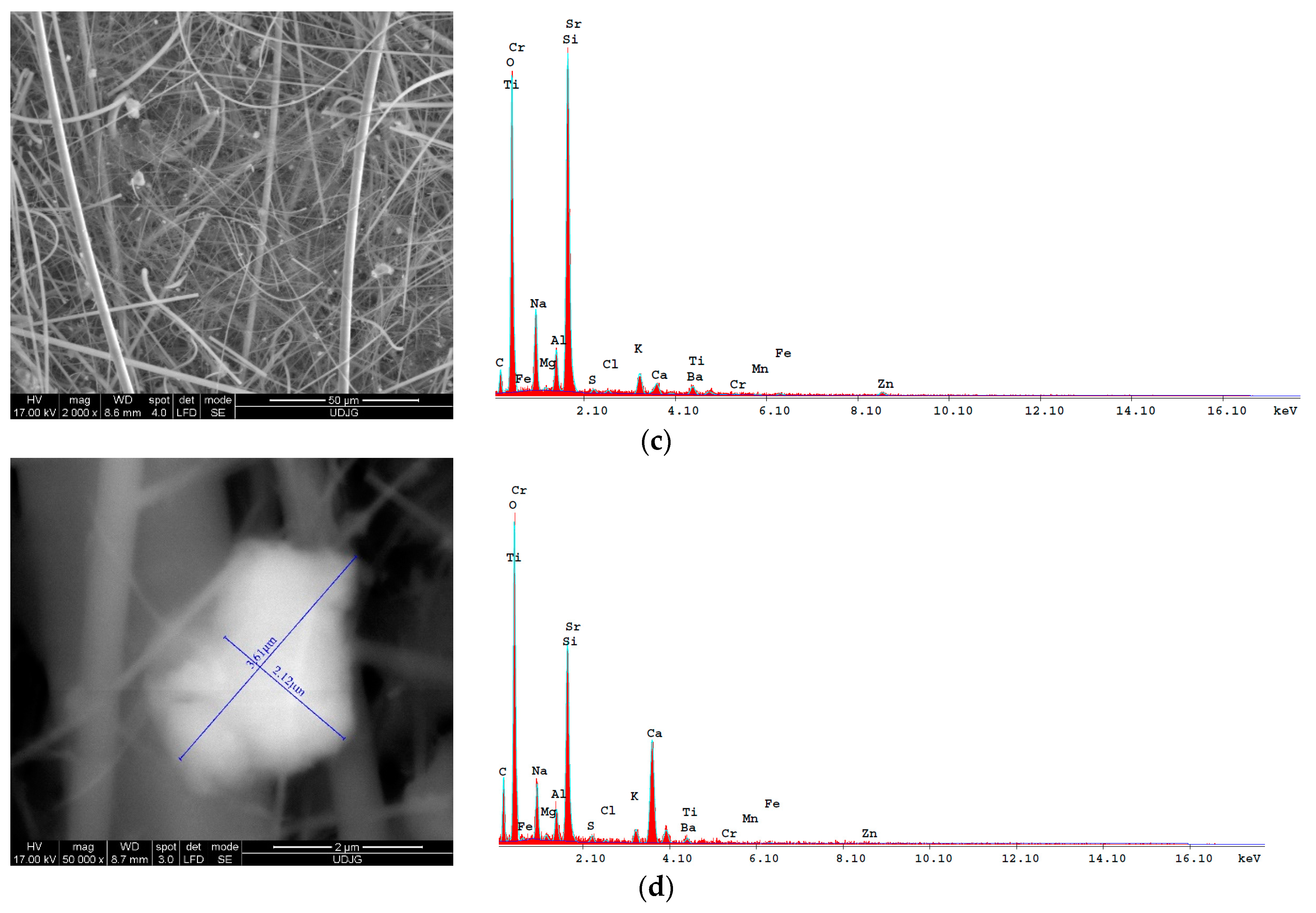Morphological and Chemical Characterization of Particulate Matter from an Indoor Measuring Campaign
Abstract
:1. Introduction
2. Materials and Methods
3. Results and Discussion
3.1. Optical Microscopy
3.2. SEM and EDX Analysis
3.3. X-ray Diffraction Analysis
4. Conclusions
Author Contributions
Funding
Institutional Review Board Statement
Data Availability Statement
Conflicts of Interest
References
- Morawska, L.; Zhu, T.; Liu, N.; Torkmahalleh, M.A.; de Fatima Andrade, M.; Barratt, B.; Broomandi, P.; Buonanno, G.; Belalcazar Ceron, L.C.; Chen, J.; et al. The state of science on severe air pollution episodes: Quantitative and qualitative analysis. Environ. Int. 2021, 156, 106732. [Google Scholar] [CrossRef] [PubMed]
- World Health Organization; Regional Office for Europe. Health Risks of Air Pollution in Europe—HRAPIE Project, Recommendations for Concentration–Response Functions for Cost–Benefit Analysis of Particulate Matter, Ozone and Nitrogen Dioxide. Available online: https://www.euro.who.int/__data/assets/pdf_file/0006/238956/Health_risks_air_pollution_HRAPIE_project.pdf (accessed on 13 July 2021).
- World Health Organization; Regional Office for Europe. Review of Evidence on Health Aspects of Air Pollution-REVIHAAP Project Technical Report. Available online: https://www.euro.who.int/__data/assets/pdf_file/0004/193108/REVIHAAP-Final-technical-report-final-version.pdf (accessed on 13 July 2021).
- Wu, B.; Bai, X.; Liu, W.; Zhu, C.; Hao, Y.; Lin, S.; Luo, L.; Liu, X.; Zhao, S.; Hao, J.; et al. Variation characteristics of final size-segregated PM emissions from ultralow emission coal-fired power plants in China. Environ. Pollut. 2020, 259, 113886. [Google Scholar] [CrossRef]
- Samek, L.; Stegowski, Z.; Furman, L.; Styszko, K.; Szramowiat, K.; Fiedor, J. Quantitative Assessment of PM 2.5 Sources and Their Seasonal Variation in Krakow. Water Air Soil Pollut. 2017, 228, 1–11. [Google Scholar] [CrossRef]
- Khamraev, K.; Cheriyan, D.; ho Choi, J. A review on health risk assessment of PM in the construction industry—Current situation and future directions. Sci. Total Environ. 2021, 758, 143716. [Google Scholar] [CrossRef]
- Tian, G.; Wang, J.; Lu, Z.; Wang, H.; Zhang, W.; Ding, W.; Zhang, F. Indirect effect of PM1 on endothelial cells via inducing the release of respiratory inflammatory cytokines. Toxicol. Vitr. 2019, 57, 203–210. [Google Scholar] [CrossRef] [PubMed]
- Apte, J.S.; Brauer, M.; Cohen, A.J.; Ezzati, M.; Arden Pope, I.C. Ambient PM2.5 Reduces Global and Regional Life Expectancy. Environ. Sci. Technol. Lett. 2018, 5, 546–551. [Google Scholar] [CrossRef]
- Hsieh, N.-H.; Liao, C.-M.; Hsieh, N.-H.; Liao, C.-M. Assessing exposure risk for dust storm events-associated lung function decrement in asthmatics and implications for control. Atmos. Environ. 2013, 68, 256–264. [Google Scholar] [CrossRef]
- Wang, N.; Mengersen, K.; Tong, S.; Kimlin, M.; Zhou, M.; Liu, Y.; Hu, W. County-level variation in the long-term association between PM2.5 and lung cancer mortality in China. Sci. Total Environ. 2020, 738, 140195. [Google Scholar] [CrossRef]
- Feng, L.; Xu, D.; Cheng, Y.; Dong, S.; Guo, C.; Jiang, X.; Zheng, X. Systematic review and meta-analysis of the adverse health effects of ambient PM2.5 and PM10 pollution in the Chinese population. Environ. Res. 2015, 136, 196–204. [Google Scholar] [CrossRef]
- Franzin, B.T.; Guizellini, F.C.; de Babos, D.V.; Hojo, O.; Pastre, I.A.; Marchi, M.R.; Fertonani, F.L.; Oliveira, C.M.R.R. Characterization of atmospheric aerosol (PM10 and PM2.5) from a medium sized city in São Paulo state, Brazil. J. Environ. Sci. 2020, 89, 238–251. [Google Scholar] [CrossRef]
- Bowe, B.; Xie, Y.; Li, T.; Yan, Y.; Xian, H.; Al-Aly, Z. The 2016 global and national burden of diabetes mellitus attributable to PM 2·5 air pollution. Lancet Planet. Health 2018, 2, e301–e312. [Google Scholar] [CrossRef]
- Borup, H.; Kirkeskov, L.; Hanskov, D.J.A.; Brauer, C. Systematic review: Chronic obstructive pulmonary disease and construction workers. Occup. Med. 2017, 67, 199–204. [Google Scholar] [CrossRef]
- Ringen, K.; Dement, J.; Welch, L.; Dong, X.S.; Bingham, E.; Quinn, P.S. Risks of a lifetime in construction. Part II: Chronic occupational diseases. Am. J. Ind. Med. 2014, 57, 1235–1245. [Google Scholar] [CrossRef]
- Pipal, A.S.; Kulshrestha, A.; Taneja, A. Characterization and morphological analysis of airborne PM2.5 and PM10 in Agra located in north central India. Atmos. Environ. 2011, 45, 3621–3630. [Google Scholar] [CrossRef]
- Gao, Y.; Ji, H. Microscopic morphology and seasonal variation of health effect arising from heavy metals in PM2.5 and PM10: One-year measurement in a densely populated area of urban Beijing. Atmos. Res. 2018, 212, 213–226. [Google Scholar] [CrossRef]
- Quijano, M.F.C.; Mateus, V.L.; Saint’Pierre, T.D.; Bott, I.S.; Gioda, A. Exploratory and comparative analysis of the morphology and chemical composition of PM 2.5 from regions with different socioeconomic characteristics. Microchem. J. 2019, 147, 507–515. [Google Scholar] [CrossRef]
- Sarda-Esteve, R.; Baisnee, D.; Guinot, B.; Filippi, D.; O’connor, D.; Sciare, J. A new instrument for realtime detection of aeroallergens and particulate matter by optical microscopy. Rev. Française D’allergologie 2022, 62, 329. [Google Scholar] [CrossRef]
- Koval, S.; Krahenbuhl, G.; Warren, K.; O’Brien, G. Optical microscopy as a new approach for characterising dust particulates in urban environment. J. Environ. Manag. 2018, 223, 196–202. [Google Scholar] [CrossRef]
- Mateus, V.L.; Gioda, A. A candidate framework for PM2.5 source identification in highly industrialized urban-coastal areas. Atmos. Environ. 2017, 164, 147–164. [Google Scholar] [CrossRef]
- González, L.T.; Rodríguez, F.L.; Sánchez-Domínguez, M.; Leyva-Porras, C.; Silva-Vidaurri, L.G.; Acuna-Askar, K.; Kharisov, B.I.; Chiu, J.F.V.; Barbosa, J.M.V. Chemical and morphological characterization of TSP and PM2.5 by SEM-EDS, XPS and XRD collected in the metropolitan area of Monterrey, Mexico. Atmos. Environ. 2016, 143, 249–260. [Google Scholar] [CrossRef]
- Yao, X.; Chan, C.K.; Fang, M.; Cadle, S.; Chan, T.; Mulawa, P.; He, K.; Ye, B. The water-soluble ionic composition of PM2.5 in Shanghai and Beijing, China. Atmos. Environ. 2002, 36, 4223–4234. [Google Scholar] [CrossRef]
- Mateus, V.L.; Monteiro, I.L.G.; Rocha, R.C.C.; Saint’Pierre, T.D.; Gioda, A. Study of the chemical composition of particulate matter from the Rio de Janeiro metropolitan region, Brazil, by inductively coupled plasma-mass spectrometry and optical emission spectrometry. Spectrochim. Acta-Part B At. Spectrosc. 2013, 86, 131–136. [Google Scholar] [CrossRef]
- Mariani, R.L.; de Mello, W.Z. PM2.5-10, PM2.5 and associated water-soluble inorganic species at a coastal urban site in the metropolitan region of Rio de Janeiro. Atmos. Environ. 2007, 41, 2887–2892. [Google Scholar] [CrossRef]
- Alastuey, A.; Querol, X.; Castillo, S.; Escudero, M.; Avila, A.; Cuevas, E.; Torres, C.; Romero, P.-M.; Exposito, F.; García, O.; et al. Characterisation of TSP and PM2.5 at Izaña and Sta. Cruz de Tenerife (Canary Islands, Spain) during a Saharan Dust Episode (July 2002). Atmos. Environ. 2005, 39, 4715–4728. [Google Scholar] [CrossRef]
- Maia, P.D.; Vieira-Filho, M.; Prado, L.F.; da Silva, L.C.M.; Sodré, F.F.; Ribeiro, H.D.S.V.; Ventura, R.S. Assessment of atmospheric particulate matter (PM10) in Central Brazil: Chemical and morphological aspects. Atmos. Pollut. Res. 2022, 13, 101362. [Google Scholar] [CrossRef]
- Bodor, M.; Baltă, Ș.; Lazăr, L.; Pintilie, Ș.; Buruiana, D.L. Studies Regarding the Distribution and Composition of Particulate Matters in the Air of an Industrialized City. In Proceedings of the 16th International Multidisciplinary Scientific GeoConference SGEM, Albena, Bulgaria, 30 June–6 July 2016; Volume 2, pp. 587–591. [Google Scholar]
- Bodor, M. Indoor Concentration and Composition of Fine Particulate Matter (PM2.5) Near an Intense Circulated Road in an Industrial City. Ann. “Dunarea De Jos” Univ. Galati. Fascicle IX Metall. Mater. Sci. 2020, 43, 5–10. [Google Scholar] [CrossRef]
- Bodor, M. A study on indoor particulate matter variation in time based on count and sizes and in relation to meteorological conditions. Sustainability 2021, 13, 8263. [Google Scholar] [CrossRef]
- Siciliano, T.; Giua, R.; Siciliano, M.; di Giulio, S.; Genga, A. The morphology and chemical composition of the urban PM10 near a steel plant in Apulia determined by scanning electron microscopy. Source Apportionment. Atmos. Res. 2021, 251, 105416. [Google Scholar] [CrossRef]
- Choung, S.; Oh, J.; Han, W.S.; Chon, C.M.; Kwon, Y.; Shin, W. Comparison of physicochemical properties between fine (PM2.5) and coarse airborne particles at cold season in Korea. Sci. Total Environ. 2016, 541, 1132–1138. [Google Scholar] [CrossRef] [PubMed]




Publisher’s Note: MDPI stays neutral with regard to jurisdictional claims in published maps and institutional affiliations. |
© 2022 by the authors. Licensee MDPI, Basel, Switzerland. This article is an open access article distributed under the terms and conditions of the Creative Commons Attribution (CC BY) license (https://creativecommons.org/licenses/by/4.0/).
Share and Cite
Bodor, M.; Ceoromila, A.; Bașliu, V. Morphological and Chemical Characterization of Particulate Matter from an Indoor Measuring Campaign. Sustainability 2022, 14, 11621. https://doi.org/10.3390/su141811621
Bodor M, Ceoromila A, Bașliu V. Morphological and Chemical Characterization of Particulate Matter from an Indoor Measuring Campaign. Sustainability. 2022; 14(18):11621. https://doi.org/10.3390/su141811621
Chicago/Turabian StyleBodor, Marius, Alina Ceoromila, and Vasile Bașliu. 2022. "Morphological and Chemical Characterization of Particulate Matter from an Indoor Measuring Campaign" Sustainability 14, no. 18: 11621. https://doi.org/10.3390/su141811621
APA StyleBodor, M., Ceoromila, A., & Bașliu, V. (2022). Morphological and Chemical Characterization of Particulate Matter from an Indoor Measuring Campaign. Sustainability, 14(18), 11621. https://doi.org/10.3390/su141811621






